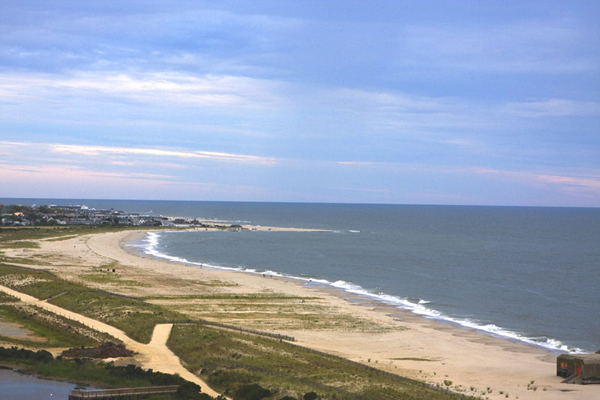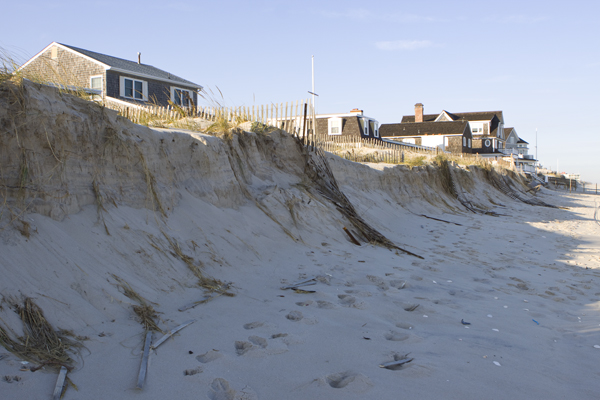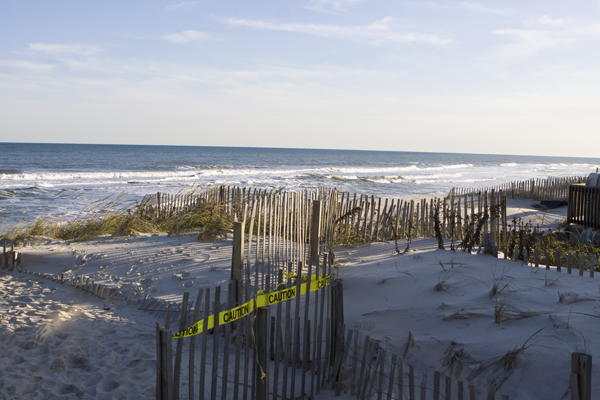Another Emergency Declaration Along the Shore
[11/17/09 update – photo’s below]
In light of another coastal storm damage state of emergency declared by Governor Corzine in the wake of the most recent nor’easter, we repost what we issued on September 25, 2006:

View of Cape May, NJ, from Lighthouse
But first, here are warnings from DEP’s Coastal Assessment Report to the federal government – warnings that have been long ignored:
Many parts of New Jersey’s densely populated coastal area are highly susceptible to the effects of the following coastal hazards: flooding, storm surge, episodic erosion, chronic erosion, sea level rise, and extra-tropical storms. Reconstruction of residential development and the conversion of single family dwellings into multi-unit dwellings continues in hazardous areas… the value of property at risk is increasing significantly. With anticipated accelerating sea level rise and increasing storm frequency and intensity, vulnerability to the risks of coastal hazards will not abate; it will only become more costly.
Development in areas suited to the inland migration of coastal wetlands serves to preclude this adaptation and the wetlands will either diminish in extent or will be lost to inundation. …
All of the impediments to meeting this 309 programmatic objective that appeared in the last New Jersey Coastal Zone Section 309 Assessment and Strategy remain. These include lobbying efforts of special interest groups, legal challenges to DEP permit decisions, provision of flood insurance through the National Flood Insurance Program, and public perception that large-scale beach nourishment projects eliminate vulnerability to coastal hazards.
Titus demonstrates (link) that in certain instances, structural engineering solutions will not be practical or economically feasible. In these cases future public and private development and redevelopment must be directed away from the hazardous areas. While some derogatorily refer to this option as “retreat,” from the perspective of sound planning based on the best available science, the concept actually involves “strategic adjustment.” Prudent planning requires that we expand upon the existing studies of the societal, economic, and environmental costs of possible mitigative actions while the greatest number of alternatives exist.The state’s coastal area continues to experience substantial seasonal and residential population increases. Conversion of formerly seasonal homes to year-round residences continues unabated. In many instances, formerly modest houses are replaced with significantly more expensive homes while property values continue to escalate.
At the same time, risks associated with coastal hazards continue to increase. Factors such as escalating sea level rise and cyclical and possibly long-term increases in storm frequency and intensity threaten both the natural environment and built environment of New Jersey’s coast. Consequently, the ranking of the Coastal Hazards Section 309 enhancement area remains a high priority with the NJCMP. [end excerpt – link to complete DEP document below]
JERSEY SHORE HIGHLY VULNERABLE TO STORMS AND SEA LEVEL RISE
Environmentalists Urge Corzine Administration to Include Global Warming and Land Use Reforms in Pending Insurance Industry Bailout
TRENTON- As Corzine Administration officials met quietly behind closed doors with insurance and finance industry leaders to discuss a statewide insurance fund to finance catastrophic shore storm risks, environmentalists called on the Governor to incorporate much needed coastal development and global warming policy reforms in any industry bailout package.
Numerous scientific studies and NJDEP Reports show that the over-developed NJ shore is increasingly vulnerable to hurricane and storm related wind, storm surge, and flooding damage. Those risks are magnified by the effects of global warming induced sea level rise. NJ already is among the worst states in the nation for payouts on repeat claims under the federal flood insurance program. While risks are great and growing, DEP’s own studies show that public awareness is low, and local and state disaster planning and emergency response capabilities are woefully inadequate.
Despite these significant risks, continued over-development, particularly in known high hazard areas along the shore, puts more people and property in harms way, greatly increasing not only risks to life and property. The probability is increasing for a catastrophic coastal storm event that would cause huge economic dislocation.
The multi-billion dollar scope of the problem and potential insurance liability has led insurance industry leaders to withdrawn from insurance markets in the tri-state region, and to seek a public bailout of insured liability.
In response to this industry concern, Corzine Administration officials in the Departments of Insurance and Environmental Protection have been meeting to negotiate a policy initiative. There is rumored to be a meeting with industry leaders today.
In order to shape this initiative, environmentalists released a set of policy reforms that should be included in any coastal insurance related package.
There should be no insurance industry bailout on the backs of homeowners unless serious coastal land use and global warming reforms are included in the package to reduce the current magnitude of catastrophic risks.
1) Because global warming is known to increase storm intensity, storm surge, wind, and flooding risks, (and some argue storm frequency), enforceable global warming prevention policies must be part of the package.
“When it comes to global warming policy, the Governor’s priorities are skewed. Everyone is threatened by the effects of global warming, not just the insurance industry. The Governor’s priority should be developing a plan to solve global warming in the first place,” said Dena Mottola, Executive Director of Environment New Jersey, the new home of NJPIRG’s environmental work. “As a heavily populated state, New Jersey’s commitment to tackling global warming can have a big impact. By developing a global warming action plan for the state, Governor Corzine can show that New Jersey has the brainpower and technological know how to show other states and the nation that solving global warming is more than possible.”
2) The financing mechanism for the insurance risk must include dedicated funding to acquire at risk properties, storm damaged properties, and an increase in the current Statewide “blue acres” program acquisition funding;
“We can not allow the homeowners of New Jersey to subsidize multi-million dollar mansion built into sand dunes. Instead we must change our Coastal Programs and stop putting people in harms way” said Jeff Tittel, Director, NJ Sierra Club.
3) New development in coastal high hazard areas must be curtailed. It makes no sense to develop a catastrophic risk fund while continuing to put more people and property at risk along NJ’s already highly vulnerable and over-developed coastal zone. Loopholes in the CAFRA coastal land use law must be closed and existing restrictions on development in high hazard and environmentally sensitive areas strengthened;
4) The current “right to rebuild” storm damaged properties must be eliminated;
5) Additional resources must be provided to bolster local and state emergency prevention, preparedness, and response planning. Towns must be given additional legal planning tools to manage these risks;
“The Corzine Administration and insurance industry have the potential to be powerful allies against global warming. While the solution is complex, more focus should be on inclusive, public, and aggressive reforms of the state’s air, energy and land use policies than on some taxpayer or homeowner financed insurance fund” said David Pringle, Campaign Director, NJ Environmental Federation.
“The public’s business must be done openly and transparently in the disinfecting light of day. State government is not Wall Street and public policy development is not the art of negotiating the deal”, concluded Bill Wolfe, Director, NJ PEER.
###
Learn more about the threat of sprawl to New Jersey’s coast
Look at legislation to subsidize the insurance industry and more coastal sprawl
Compare the insurance industry press release and agenda for Connecticut
See the state’s coastal assessment
And the environmental community’s response

beach and dunes severely eroded behind homes in Normandy Beach

about 7 foot dropoff behind homes in Normandy Beach

Dunes completely gone, ocean was in the basement - stairs washed out - workers dig out sand - Normandy Beach

5-6 feet of beach gone - Normandy Beach, NJ

Hi. I am a long time reader. I wanted to say that I like your blog and the layout.
Peter Quinn
Bill, good that you are connecting the dots for people on storm damage and coastal development. The same things happens after every bad storm. The officials rush to the beach and say, “my God look how bad this is.” And try to get emergency money to fix it.
The truth is, most of that sand is not “lost” is is nearby, offshore. In the coming months it will return and in summer the beach will look the same. No emergency, no emergency funds needed for most of the state. FEMA rules actually spell this out. They can’t give $ for loss of beach, they can only give money for loss of dune – a true emergency. True, lots of dunes were lost and they should be rebuilt. But the state will play a game and try to get the feds to pay for new beaches. Thankfully FEMA usually is on to their game.